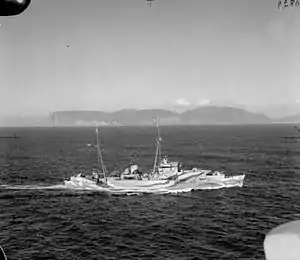HMS Palomares
HMS Palomares was originally MV Palomares, built by William Doxford & Sons, Sunderland yard in 1937 and sailed as a merchant fruit carrier ship (13.5 knot banana boat) for service on the MacAndrews Line in January 1938 with their Spanish service.
 HMS Palomares in August 1941 | |
| History | |
|---|---|
| Name: | MV Palomares |
| Operator: | MacAndrews Line |
| Builder: | William Doxford & Sons, Sunderland |
| Launched: | 20 October 1937 |
| Out of service: | 1940 |
| Fate: | Sold |
| Name: | HMS Palomares |
| Owner: | Royal Navy |
| Acquired: | 1940 |
| Identification: | pennant F 98 |
| Fate: | Sold |
| Name: | MV Palomares |
| Operator: | MacAndrews Line |
| Acquired: | Post WWII |
| Out of service: | Mid-1950s |
| General characteristics as HMS Palomares | |
| Tonnage: | 1896 GRT |
| Armament: | 4x2 4-inch guns, 2x4 2-pdr guns |
She was purchased by the British Admiralty in 1940, as these fruit ships were considered to be fast and manoeuvrable. In 1941 the Admiralty converted her and seven others to Anti-aircraft Artillery ships and eventually Fighter Direction Ships (seagoing Anti Aircraft Auxiliaries). Most likely the conversion took place at Fairfields yard in Govan on the Clyde with her sister ship HMS Pozarica.
Noted operations
In March 1942, she sailed with Pozarica, and the corvettes Poppy, Lotus, La Malouine and Dianella for the port of Seyðisfjörður.
In June 1942, she sailed as an escort in the infamous Convoy PQ 17, where 25 out 36 ships were lost to the enemy, while working around Murmansk and Archangel.[1]
In November 1942, HMS Palomares took part in the Operation Torch landings in Algiers as an Anti Aircraft ship. The ship left Gibraltar on the 3rd and arriving on the 8th. However the next day Palomares was hit by a bomb suffering a large number of casualties, engulfed in flames her steering gear was put out of action. Deceased seamen were transferred to the corvette Samphire for burial at sea and her steering gear was repaired by the 10th.[1]
In September 1943, during the Salerno landings of Italy on the 9th, Palomares was a Fighter Direction ship, directing fighter planes with her radar system.
In January 1944, Palomares again served as a Fighter Direction ship during the Anzio landings. Arriving at the beachhead on the 22nd, she struck a mine and was towed back to Naples by the tugs Edenshaw and Evea.
In September 1945, Palomares was to have participated in the Malaya landings but couldn't as fire damaged her engine room.
Armaments and displacement
Upon being converted as an Anti Aircraft ship HMS Palomares was equipped with eight 4-inch AA guns in four turrets and eight 2-pounder (40mm) AA gunsin two quadruple mounts. In December 1942, to take the role as a fighter-direction ship, Palomares was fitted with radar for directing fighter aircraft.[2]
HMS Palomares had a weight of 1,896 tons and could move at 13.5 Knots.
Returned
Surviving the war, HMS Palomares was returned to the MacAndrews Line in 1946, where she continued service until the mid-1950s.[3]
References
- "157484 Assistant Steward Norman Dennis Rigley". www.cookstownwardead.co.uk. Retrieved 11 October 2012.
- "HMS Palomares (F 98)". uboat.net. Retrieved 11 October 2012.
- "HMS Pozarica". www.red-rooster.co.uk. Archived from the original on 12 May 2008. Retrieved 11 October 2012.